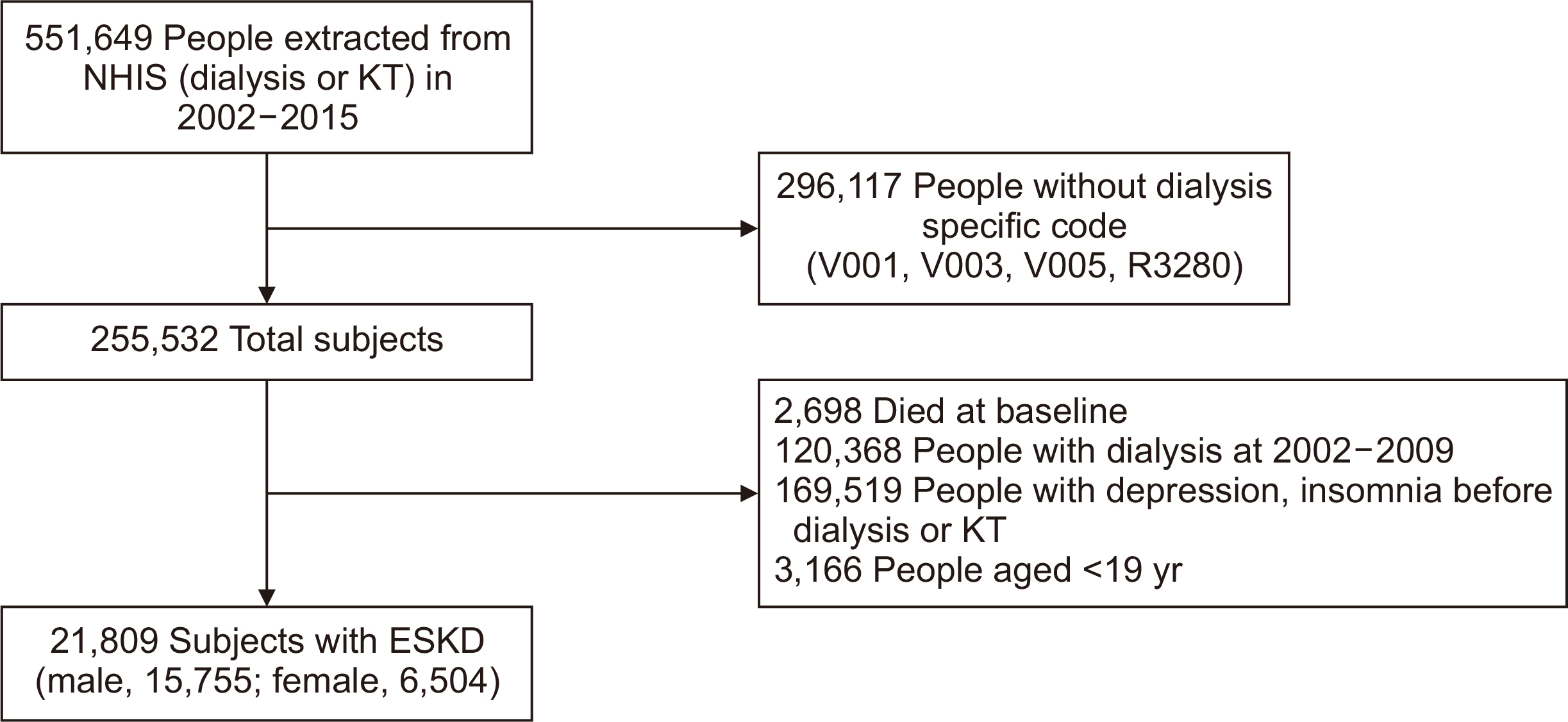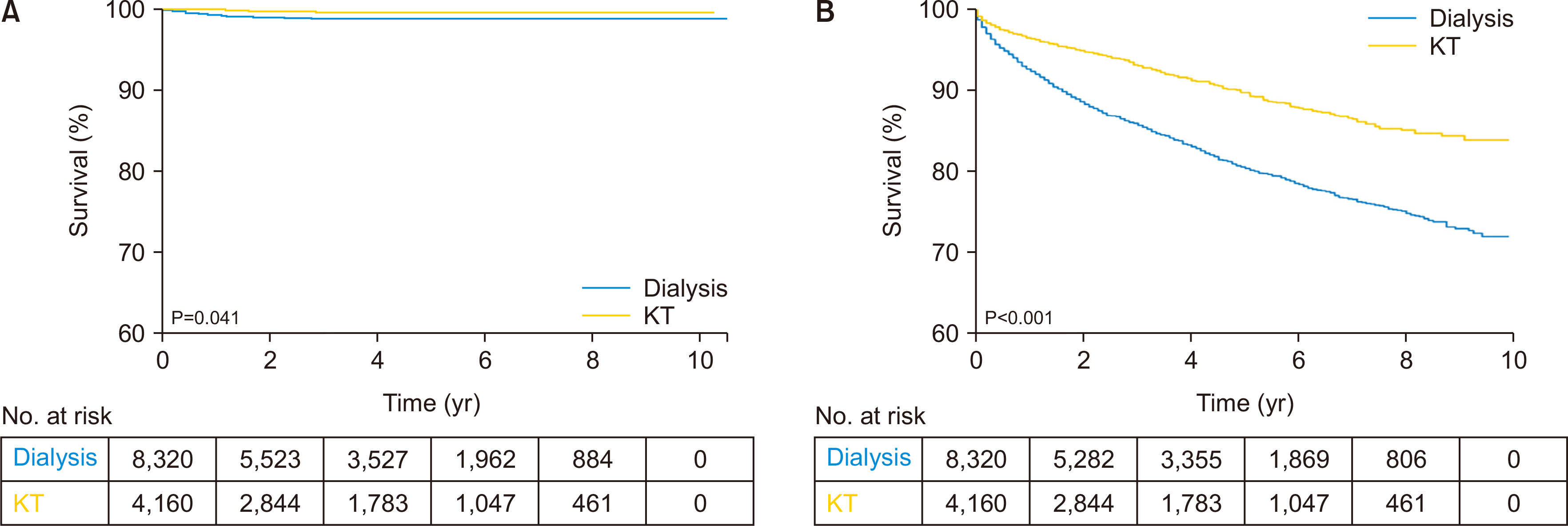Clin Transplant Res.
2024 Jun;38(2):98-105. 10.4285/ctr.24.0004.
Comparison of depression and suicide between dialysis and kidney transplant recipients in Korea: a nationwide population study
- Affiliations
-
- 1Department of Internal Medicine, Yonsei University Wonju College of Medicine, Wonju, Korea
- 2Department of Biostatistics, Yonsei University Wonju College of Medicine, Wonju, Korea
- 3Department of Precision Medicine, Yonsei University Wonju College of Medicine, Wonju, Korea
- 4Department of Psychiatry, Yonsei University Wonju College of Medicine, Wonju, Korea
- 5Transplantation Center, Wonju Severance Christian Hospital, Wonju, Korea
- KMID: 2557603
- DOI: http://doi.org/10.4285/ctr.24.0004
Abstract
- Background
Kidney transplantation (KT) improves physical and psychological prognoses for patients with end-stage kidney disease (ESKD). However, few comparative studies have examined depression and suicide rates among patients with ESKD treated with dialysis versus KT.
Methods
Data on 21,809 patients with ESKD were extracted from the Korean National Health Insurance Service database, extending from January 2002 to December 2018. These patients exhibited no history of depression or insomnia before starting renal replacement therapy. Outcomes were compared between dialysis and KT recipients using 1:2 propensity score matching (PSM).
Results
Of the patients, 17,649 received dialysis (hemodialysis, 15,537; peritoneal dialysis, 2,112), while 4,160 underwent KT. Of those on dialysis, 45.04% (7,949) experienced insomnia, compared to 25.72% (1,070) of KT recipients (P<0.001). Depression was more frequent among dialysis recipients (22.77%, 4,019) than KT recipients (8.61%, 358; P<0.001). Additionally, those on dialysis had a higher incidence of suicide (0.19%, 33) than recipients of KT (0.12%, 5; P=0.047). After PSM, the hazard ratio (HR) for depression in patients on dialysis compared to KT recipients was 1.76 (95% confidence interval [CI], 1.56–1.99). In subgroup analysis, the relative likelihood of depression among dialysis recipients was particularly high for residents of urban areas (HR, 2.10; 95% CI, 1.80–2.44) and patients under 65 years old (HR, 1.82; 95% CI, 1.62–2.09).
Conclusions
KT recipients exhibit a lower suicide rate than patients on dialysis. Furthermore, KT is associated with a lower prevalence of depression among Korean patients with ESKD, particularly urban residents and individuals under 65 years old.
Keyword
Figure
Reference
-
1. Wolfe RA, Ashby VB, Milford EL, Ojo AO, Ettenger RE, Agodoa LY, et al. 1999; Comparison of mortality in all patients on dialysis, patients on dialysis awaiting transplantation, and recipients of a first cadaveric transplant. N Engl J Med. 341:1725–30. DOI: 10.1056/NEJM199912023412303. PMID: 10580071.2. Hariharan S, Johnson CP, Bresnahan BA, Taranto SE, McIntosh MJ, Stablein D. 2000; Improved graft survival after renal transplantation in the United States, 1988 to 1996. N Engl J Med. 342:605–12. DOI: 10.1056/NEJM200003023420901. PMID: 10699159.
Article3. Neale J, Smith AC. 2015; Cardiovascular risk factors following renal transplant. World J Transplant. 5:183–95. DOI: 10.5500/wjt.v5.i4.183. PMID: 26722646. PMCID: PMC4689929.
Article4. Carvalho EV, Reboredo MM, Gomes EP, Teixeira DR, Roberti NC, Mendes JO, et al. 2014; Physical activity in daily life assessed by an accelerometer in kidney transplant recipients and hemodialysis patients. Transplant Proc. 46:1713–7. DOI: 10.1016/j.transproceed.2014.05.019. PMID: 25131019.
Article5. Laupacis A, Keown P, Pus N, Krueger H, Ferguson B, Wong C, et al. 1996; A study of the quality of life and cost-utility of renal transplantation. Kidney Int. 50:235–42. DOI: 10.1038/ki.1996.307. PMID: 8807593.
Article6. Alavi NM, Aliakbarzadeh Z, Sharifi K. 2009; Depression, anxiety, activities of daily living, and quality of life scores in patients undergoing renal replacement therapies. Transplant Proc. 41:3693–6. DOI: 10.1016/j.transproceed.2009.06.217. PMID: 19917369.7. Andrade SV, Sesso R, Diniz DH. 2015; Hopelessness, suicide ideation, and depression in chronic kidney disease patients on hemodialysis or transplant recipients. J Bras Nefrol. 37:55–63. DOI: 10.5935/0101-2800.20150009. PMID: 25923751.
Article8. Lin HT, Lai CH, Perng HJ, Chung CH, Wang CC, Chen WL, et al. 2018; Insomnia as an independent predictor of suicide attempts: a nationwide population-based retrospective cohort study. BMC Psychiatry. 18:117. DOI: 10.1186/s12888-018-1702-2. PMID: 29716570. PMCID: PMC5930777.9. Novak M, Molnar MZ, Ambrus C, Kovacs AZ, Koczy A, Remport A, et al. 2006; Chronic insomnia in kidney transplant recipients. Am J Kidney Dis. 47:655–65. DOI: 10.1053/j.ajkd.2005.12.035. PMID: 16564943.
Article10. Seong SC, Kim YY, Khang YH, Park HJ, Kang HJ, Lee H, et al. 2017; Data resource profile: the National Health Information Database of the National Health Insurance Service in South Korea. Int J Epidemiol. 46:799–800. DOI: 10.1093/ije/dyw253. PMID: 27794523. PMCID: PMC5837262.11. Kim GE, Jo MW, Shin YW. 2020; Increased prevalence of depression in South Korea from 2002 to 2013. Sci Rep. 10:16979. DOI: 10.1038/s41598-020-74119-4. PMID: 33046758. PMCID: PMC7550589.
Article12. Chung S, Cho SW, Jo MW, Youn S, Lee J, Sim CS. 2020; The prevalence and incidence of insomnia in Korea during 2005 to 2013. Psychiatry Investig. 17:533–40. DOI: 10.30773/pi.2019.0218. PMID: 32450623. PMCID: PMC7324735.
Article13. You BS, Jeong KH, Cho HJ. 2020; Regional suicide rate change patterns in Korea. Int J Environ Res Public Health. 17:6973. DOI: 10.3390/ijerph17196973. PMID: 32987626. PMCID: PMC7579164.
Article14. D'Agostino RB Jr. 1998; Propensity score methods for bias reduction in the comparison of a treatment to a non-randomized control group. Stat Med. 17:2265–81. DOI: 10.1002/(SICI)1097-0258(19981015)17:19<2265::AID-SIM918>3.0.CO;2-B. PMID: 9802183.15. Hsu HJ, Yen CH, Chen CK, Wu IW, Lee CC, Sun CY, et al. 2013; Association between uremic toxins and depression in patients with chronic kidney disease undergoing maintenance hemodialysis. Gen Hosp Psychiatry. 35:23–7. DOI: 10.1016/j.genhosppsych.2012.08.009. PMID: 23044245.
Article16. Jhee JH, Lee E, Cha MU, Lee M, Kim H, Park S, et al. 2017; Prevalence of depression and suicidal ideation increases proportionally with renal function decline, beginning from early stages of chronic kidney disease. Medicine (Baltimore). 96:e8476. DOI: 10.1097/MD.0000000000008476. PMID: 29095304. PMCID: PMC5682823.
Article17. Kimmel PL. 2001; Psychosocial factors in dialysis patients. Kidney Int. 59:1599–613. DOI: 10.1046/j.1523-1755.2001.0590041599.x. PMID: 11260433.
Article18. Israel M. 1986; Depression in dialysis patients: a review of psychological factors. Can J Psychiatry. 31:445–51. DOI: 10.1177/070674378603100513. PMID: 3524786.19. Chen CK, Tsai YC, Hsu HJ, Wu IW, Sun CY, Chou CC, et al. 2010; Depression and suicide risk in hemodialysis patients with chronic renal failure. Psychosomatics. 51:528. DOI: 10.1016/S0033-3182(10)70747-7. PMID: 21051686.
Article20. Shirazian S, Grant CD, Aina O, Mattana J, Khorassani F, Ricardo AC. 2016; Depression in chronic kidney disease and end-stage renal disease: similarities and differences in diagnosis, epidemiology, and management. Kidney Int Rep. 2:94–107. DOI: 10.1016/j.ekir.2016.09.005. PMID: 29318209. PMCID: PMC5720531.
Article21. Schaefer F, Vogel M, Kerkhoff G, Woitzik J, Daschner M, Mehls O. 2001; Experimental uremia affects hypothalamic amino acid neurotransmitter milieu. J Am Soc Nephrol. 12:1218–27. DOI: 10.1681/ASN.V1261218. PMID: 11373345.
Article22. Andreazza AC, Kauer-Sant'anna M, Frey BN, Bond DJ, Kapczinski F, Young LT, et al. 2008; Oxidative stress markers in bipolar disorder: a meta-analysis. J Affect Disord. 111:135–44. DOI: 10.1016/j.jad.2008.04.013. PMID: 18539338.23. Black CN, Bot M, Scheffer PG, Cuijpers P, Penninx BW. 2015; Is depression associated with increased oxidative stress? A systematic review and meta-analysis. Psychoneuroendocrinology. 51:164–75. DOI: 10.1016/j.psyneuen.2014.09.025. PMID: 25462890.
Article24. Himmelfarb J. 2009; Uremic toxicity, oxidative stress, and hemodialysis as renal replacement therapy. Semin Dial. 22:636–43. DOI: 10.1111/j.1525-139X.2009.00659.x. PMID: 20017834.25. Cho S, Park S, Kim JE, Yu MY, Baek SH, Han K, et al. 2022; Incidence of depression in kidney transplant recipients in South Korea: a long-term population-based study. Sci Rep. 12:17603. DOI: 10.1038/s41598-022-20828-x. PMID: 36266441. PMCID: PMC9584940.
Article26. Lee MJ, Lee E, Park B, Park I. 2022; Mental illness in patients with end-stage kidney disease in South Korea: a nationwide cohort study. Kidney Res Clin Pract. 41:231–41. DOI: 10.23876/j.krcp.21.047. PMID: 34974656. PMCID: PMC8995483.
Article27. Serpico S, Parsikia A, Goodarzi A, Manikath James R, Koizumi N, et al. 2022; Suicide amongst transplant recipients: trends and unique risk factors. Clin Transplant. 36:e14669. DOI: 10.1111/ctr.14669. PMID: 35398909.
Article28. Chen IM, Lin PH, Wu VC, Wu CS, Shan JC, Chang SS, et al. 2018; Suicide deaths among patients with end-stage renal disease receiving dialysis: a population-based retrospective cohort study of 64,000 patients in Taiwan. J Affect Disord. 227:7–10. DOI: 10.1016/j.jad.2017.10.020. PMID: 29045916.
Article29. World Health Organization (WHO). Suicide worldwide in 2019: global health estimates [Internet]. WHO;2021. cited 2023 May 24. Available from: https://www.who.int/publications/i/item/9789240026643.30. Nock MK, Borges G, Bromet EJ, Alonso J, Angermeyer M, Beautrais A, et al. 2008; Cross-national prevalence and risk factors for suicidal ideation, plans and attempts. Br J Psychiatry. 192:98–105. DOI: 10.1192/bjp.bp.107.040113. PMID: 18245022. PMCID: PMC2259024.
Article
- Full Text Links
- Actions
-
Cited
- CITED
-
- Close
- Share
- Similar articles
-
- Kidney Retransplantation
- A Concept Analysis of Compliance in Kidney Transplant Recipient Including Compliance with Immunosuppressive Medication
- Renal Cell Carcinoma in Kidney Transplant Recipients and Dialysis Patients
- Psychological effects of kidney transplantation in South Korea: a national-wide population study
- The Authors Reply: Renal Cell Carcinoma in Kidney Transplant Recipients and Dialysis Patients



